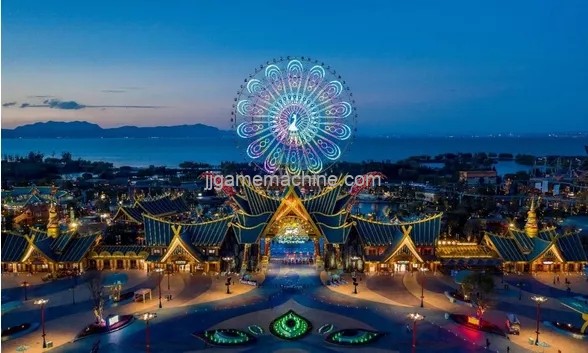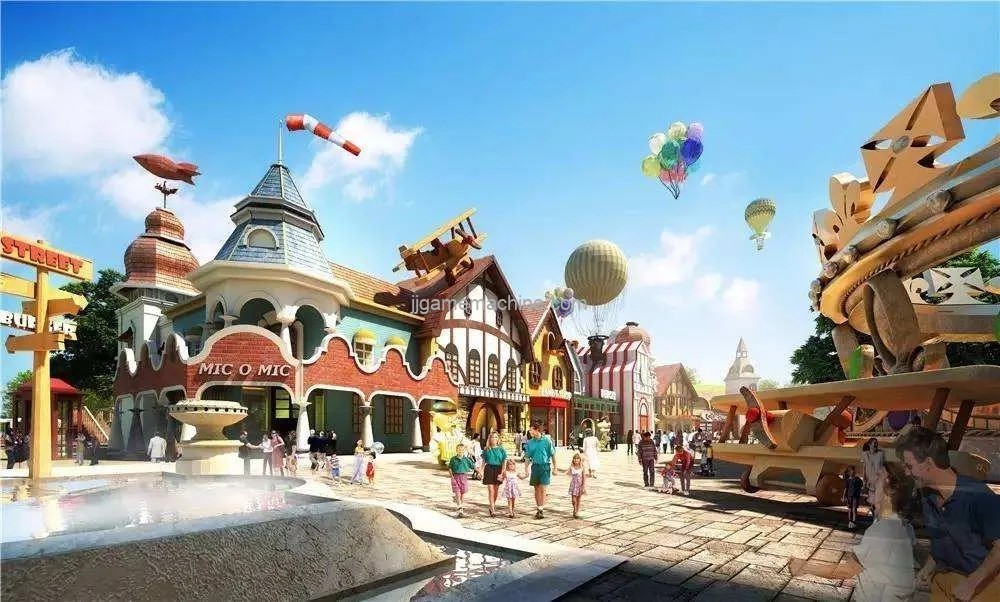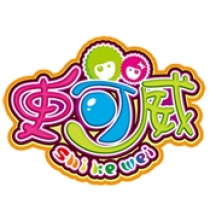With the continuous development of the times, color has become particularly important, it subtly affects people of different ages. Childhood determines a person's future growth path, is the most important stage in a person's growth process. The design of color in the park should not only meet the basic needs of children, but also play a positive role in the cultivation of children's heart.
The use of color methods are different, the design of the works will be a variety of forms, reasonable color matching can play a pleasing effect. In the design of children's playground, the most intuitive and impactful element is color, the use of color reasonable can cause people to resonate. In different age groups, children are extremely sensitive to color, so it is very important to design based on children's psychological characteristics. In our daily life, people often through the subjective feeling of vision, contact the form of objective things and see the color similarities, and produce corresponding reactions.

(Pruccik - Emotional Color Wheel)
01. The psychological impact of color on children
The results of existing psychological research show that color environment has a very important influence on children's internal development. Newborns born at just one week can distinguish between high-purity whites, greens, reds and yellows, and after four months, they can identify colors while developing certain personal preferences, according to a leading psychologist in the Journal of Child Development Psychology.
The research shows that children's mood and personality determine their color preference to some extent, which reveals children's psychological feelings. Rich color will have a great impact on children, it can promote the growth and development of children, so that children's heart beat faster, high mood, but too exaggerated, too bright colors will affect children's visual and psychological development. Bright colors can make children emotionally high in the short term, but constant stimulation can make them irritable and insecure.

In addition, the researchers found in the study of color preferences and children's psychological characteristics, dependent children love yellow; selfish children like blue; red means strong personality, naughty; pink symbolizes a loving and highly aesthetic; purple represents refreshing, easy-go personality, broad-minded; love of orange indicates active extroverts, but a little self-centered, lack of understanding.
Finally, the researchers concluded that rich colors can promote children's growth and development, but too bright colors can affect children's vision and psychological development. Children of different ages have different choice preferences, and young children are more likely to choose strong colors, which change from bright and strong to soft and coordinated with age.
02. The effect of color on children's behavior
Children's psychological development and behavior will be affected by color. Children in inffirms have very different reactions to weaker and stronger color stimuli. If the space is bright and bright, then the space is more likely to attract children's attention, on the contrary, if the color in the space is dull and gray, the child's behavior will become slow, thus affecting the child's judgment behavior. In early childhood, children develop a perception and preference for color.
Therefore, children's playground design should respect children's preference for color character and inner change. Children are curious about colorful spaces, full of exploration, and have strong feelings for good things. Therefore, children's psychology is closely related to design, the basis of design success lies in the success of children's psychology.

Principles of children's playground design
When designing a children's playground, we should not only consider the color itself, but also consider the complementary matching of the three primary colors and the colors, and pay attention to the distinctiveness, suitability and association of the colors. The overall tone should be bright and soft combination, avoid the use of monotone color system. Should uphold the "bright combination of soft, bright combination of gray, single combination of multiple" principle, clever combination of a variety of colors, so that the design of the finished works can play the best effect on children.
Take Wuhu Fangte Oriental mythical indoor children's play project "Colorful Huaxia" as an example, the whole project in the dark tunnel, children in a small boat of color drifting in the water. Among them are bright lights and starry fireworks chandeliers as embellishments, and with pleasant children's music, can achieve multiple sensory stimulation, stimulate children's interest, to achieve high user satisfaction.

Multi-ethnic decoration on both sides of the water channel can stimulate children's curiosity, so that children in the play at the same time understand the national culture, teaching in music.
When designing spaces, consider the main group of children and choose colors that are acceptable to children of all ages. Avoid using one color as the primary color system, and avoid being too monotonous to make children feel nervous and anxious. Adhering to the principle of diverse color matching design is the key to a children's amusement park to stand out from the crowd. The whole space also uses the colors in the animation, it is paired in different places, full of childlike colors, rich and clever color matching, rich and characteristic architectural style, has won the recognition and love of visitors from all over the country, which is also an important reason for its leading in the same industry.
Indoor children's play space includes indoor space interface, amusement facilities and space furnishings color design, in the design should take into account all factors, not only to achieve unity and contrast, in the layout should also avoid monotony and mixing.

Design should follow the following principles: First, functional principle, design should be people-oriented, to meet the needs of users;
Therefore, indoor children's play space needs to focus on the use of a variety of visual elements integrated design indoor space interface. The main tone to cast its good, the ground paving choose warm light color system, wall painting using hand-painted and paste way, ceiling to be beautiful, so that in line with the child's psychology, can meet the childlike fun.
For the spatial color matching of rides, choose a facility that can be integrated and meets the functional needs. The seating area should be simple and clean and matched with the overall color, and the psychological changes of children should be analyzed and different functional areas should be designed according to children's preferences.

Rich color decoration is to stimulate children and attract them to explore the unknown premise, indoor space color monotony dark, children in the way of action will become negative and slow. Therefore, for the overall interior tone design, we should consider the festival and other cultural factors and children's personality factors for a comprehensive mix. For example, for interactive facilities such as swings, we should use bright colors to catch the eye of children with warmer, brighter shades such as red and orange. Slides and swings are the main activities for children, and bright colors are more dynamic.
And indoor seating area, should choose a more gentle light color system, gentle color can make children quiet, stabilize their emotions, so that children have a sense of belonging. Different types of colors should be evenly matched to avoid one too many and one too few. When Christmas, Spring Festival and other important festivals come, should be added indoor and outdoor in line with the festive atmosphere of color decoration, so that the internal and external echo harmony. Make the space more colorful.

Outdoor children's play space design needs to have both comprehensive adaptability and characteristics, at the same time to analyze the psychology of children, different age groups to do targeted design, early childhood, weak discernment, according to its color needs for design, improve the perception of learning the environment. As a child, like to explore, should use rich colors to stimulate the psychology of exploration, enhance the enthusiasm for knowledge.
To combine different environmental factors to achieve the perfect integration of the region, all-round, multi-angle to meet the needs of all kinds of children's play. For example, to design an anime theme park, we need to deal with the overall, local and detail parts of the color matching. The overall tone should highlight the main theme, with appropriate colors to the play area walls, castles and other spatial interface rendering, to build a dreamland in line with the children's image.

The color of the castle can be the kind of glossy color, such as gold, cherry blossom powder, sky blue, I believe that such a castle will let the children immerse themselves in it, local design to highlight the functionality and interactivity of the ride, such as in the design of children's carnta, can be decorated with bright colors such as red, orange, etc. carnation patterns, but also hang some bright hanging pieces, such as the bright moon, shining stars, so that children can play in a fun environment. When designing a Ferris wheel, you can match cartoon characters with pleasing colors to make children feel as if they're flying in the air with the happy cartoon stars on the silver screen.

Rich colors will have an important impact on children's psychology and behavior, bright colors attract children, make children happy, attract them to explore. In addition, the design area can be used rain stone, pebbles and other bright colors of stone paving the road, put out the shape of small animals, flowers, animation characters;
Can be colorful facilities around the planting of green plants, it can create fresh air, but also can soothe the children and accompany the parents of the impetuous mood, at the same time, in the green with bright flowers can also play the role of painting dragon eyes.
Design that meets the multiple sensory needs of the user's vision, touch, etc. is a good spatial design. To the public as the starting point to design the public art that supports their feelings, reasonable use of color matching to present the children's dream world, such a children's play area visual communication design is successful.











